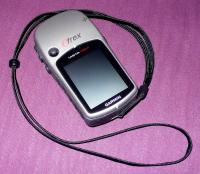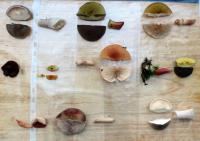Note: This entry has been restored from old archives.
Walking, rambling, trekking… call it what you will, we do like a good long trundle. Alas, we don’t always have the time and energy left on the weekend for gallivanting. We didn’t make the best use of the, rather wet, summer here in the UK, but now that the occasional crisp sunny days of the colder months have arrived we’re getting out more.
A good while back, inspired by Antonio Carluccio’s Neal Street Restaurant and the subsequent addition to our library of his Complete Mushroom Book book, we became interested in the pursuit of fungi. This, combined with our fondness for wandering, has since inspired the collection of a few more books[1] and a serfish habit of walking with eyes downcast.

Now Autumn is well upon us and legions of fungi abound! However, we’re not yet so confident as to go merrily munching away at the bounty of the woods. That said, last weekend (Oct 7th) we saw some interesting specimens in woods south of Rickmansworth and we did net ourselves a good collection of Laccaria Amethystea (the common name is Amethyst Deceiver, one of my photos is to the right but this is a far better photo). These made a pleasant addition to the evening’s pasta. Yes, we picked bright purple toadstools and then ate them!
Over the weekend just passed we became more serious in our fungal pursuit. But now I shall significantly digress to the other subject of this post: GPS. Last week I was doing a little web-shopping, thinking to get a funky LED torch[2] and/or a couple of foldable knives (for fungus gathering). In the end I came away with neither item, having been lured off target by the glingy goodness of a fancy electronic gadget.
There are many GPS units around these days, with Garmin and Magellan seeming to have the best ranges for for the off-road trekker. In the end I picked a Garmin eTrex Vista HCx, the top of the line for the eTrex range, complete with the iffy features of an electronic compass and barometric altimeter (but hey, when buying a new toy you may as well get all the geekbling! gling?). The cost/benefit analysis of the purchase decision basically came down to 50 quid extra for the altimeter, compass, and high-speed GPS hardware (with the additional cost of battery life being 25 hours rather than 32). In the end I decided that for the cost of a reasonable dinner for two… why not?
Along with the Vista I have the official Garmin TOPO Great Britain map, a bloody expensive heap of bytes. At 100 quid from many UK sellers, it seems very expensive until you stop to think that it includes topographical and road data for the entire UK. Reflect on Encyclopaedia Britannica for a moment though, remember when they produced a CDROM version and tried to flog it for a four digit price? The digression digresses… It’s the great divide between, what I think of as, “the past” versus the new “digital product generation”. Shelves of encyclopaedias that you pay thousands of units of currency for have become an anachronism and I expect many parts of that industry were laid to rest by the “digital generation”. At a time when it seems even the empires of the media distribution companies may crumble, vendor lock-in can’t keep the likes of Garmin going for long. Tomorrow the capabilities of their eTrex will be in my phone[3] and Google Earth will be the only software I need as roving communities of GPS geeks build up their own databases of topographical data. Gah! Enough idle speculation, back to my digression.

In the short time I have had to play with my geek bounty I’ve been pretty impressed. The Garmin gets a lock damn fast and the GPS tracking against their map is impressively spot on, doubly impressive to see it map into Google Maps with high accuracy as well! (More on that in a moment.) At first the screen seemed rather small (3.3×4.3cm), but it does not inhibit use of the device as much as I expected (it is also surprisingly readable in daylight). The input interface is simple, using 5 buttons and a mini-joystick, it took a little learning but after a day in the field I didn’t have to think to operate it.
So, the downsides? Well, as per earlier rant, map data is very expensive. I bought this for UK trekking so the UK map was essential (and realise, if you prefer to pay for such things this will add 50% more to the price of a good unit). While, considering the content, I think the price isn’t unjustified I also think that it is a significant “hidden cost” that really should be better disclosed in the product description and specifications. Time for some more subdigression. A system when you could license, say, 100 square miles of map would be great for the trekker. By this I mean you’d have such a license and at any one time be able to load on at most 100 square miles from an online Garmin world-map database. For something like a 20 quid yearly subscription this would seem pretty attractive. It is probably prone to having the data ripped though, but that’s nothing new — as far as I can see you can already download unlocked versions of the majority of Garmin map products from various file-sharing systems.
The second point about the maps is: don’t get your hopes up. They’re nowhere near as good as the Ordnance Survey OS and Landranger maps. Consider it this way: a Garmin GPS unit with GB TOPO maps is a near-perfect navigational aid, but keep your trusty OS handy for the fine details. The up-side is that the topographic data on the GB TOPO maps is from the OS, so it matches perfectly and it’s easy to both home in on your on-paper location, and map a waypoint into the GPS based on OS map features. As far as I can work out the TOPO maps are the best you’ll get for the Garmin, I think trying to display all the OS data would be a UI nightmare anyway.
What else is wrong with the device? Well, I find the electronic compass to be too unstable, but I might just need to get more used to it. So far I’m not convinced that I’d want to use it to take a bearing. Now to my main gripe, the little research I have done indicates that Linux basically doesn’t exist in the world of Garmin. (Shock! Horror! Oh, poor me, the big bad company doesn’t care that I’m a technodeviant!) The Win32 MapSource tool that comes with the device is a bit clunky but actually does it’s job pretty well, letting you plot out courses to upload to the GPS device and download then edit tracks and waypoints saved on your trekking. (With the insane limitation that it cuts off waypoint names at something like ten characters, what decade is this!)
What can Linux deviants turn to? Well, some dude has done a great job on a tool called gpsbabel, this does the very important task of sucking data from the unit or from files saved in MapSource format and converting them into a variety of other formats. I have found that the process that works best for me is to download data from the unit in Windows/MapSource to tidy up the tracks and waypoints as necessary, then use gpsbabel to covert the data into the format I ultimately desire: Google KML. (gpsbabel works under both Windows and Linux.) Though the KML needs to be hand cleansed, otherwise Google Maps barfs on some parts of it, I haven’t had time to take a closer look at this.
I’ve had the eTrex Vista HCx for only 4 days, so it is still “early days”. I’m hoping to work out an acceptable all-Linux solution. This might be using gpsbabel to suck from (and load to) the device and “Google Earth” to edit and create tracks and routes. The $US20 per year version of Google Earth appears to support Garmin devices, that is certainly worth exploring. Unfortunately Google Earth stopped working for me when I upgraded my Ubuntu to gutsy (I’ll echo other people in the opinion that upgrading to gutsy was mostly a PITA, last thing I wanted was bloody geek wank like compiz), I’ll wait for the free version to work again before trying the Plus version. You can also edit tracks and points with the Google Maps web-application, but I find it too laggy. (Is is just me, or has Firefox become a slow piece of crud these days, I find myself using Opera more and more often now.)
As is the way of these things I have now written a lot more about the negative than the positive. Don’t be fooled! So far I’m very happy and impressed with the new toy, it was really very pleasant company on a couple of longish walks we did this past weekend.
So, fungus I said. Gus? Who’s Gus? (Gus is the name identifier I’ve loaded onto my GPS!)

On Saturday October 20th, GPS in hand, we reprised our Whippendell Woods Walk — hunting fungi. Mapping the track from the Garmin into Google Maps left me rather impressed by both the accuracy of the GPS and the translation between the GPS and Google Maps. The trail comes up with enough accuracy to even be mostly on the correct side of the canal we followed (though often in the canal). We gathered 10 samples for later identification, which has proven to be a fun exercise. It’ll be interesting to see how long our little amateur-mycology hobby lasts. (Historically, I’m very bad at hobbies, the pattern tending to be an intense burst of focused interest shortly followed by complete and utter neglect.) The hardest part of fungus hunting is that we have an interest in finding stuff that is good to eat, gastronomic exploration is very much a part of who I am. But fungi are a bit of a dangerous minefield of creatures with names including words like “death”, “sickening”, and “poison” and on top of that we noticed this weekend that people had been through and really not treated the fungi very well. (There’s quite a bit of money in commercial harvesting of wild fungi these days, sometimes I curse the recent gourmet revolution driving up the scarcity and prices of things that used to be little-known delicacies.)
On Sunday we did a quick south-of-Ricky pub-ramble. Taking in the Ye Olde Greene Manne (nothing special, a chainpub) and the Rose and Crown (pretty good pub).
I intend to write more about both walks… though, as ever, such intentions go onto the pile with the likes of writing about some call graph visualisation I explored recently, several noteworthy places I’ve eaten at, some good coffee houses, some interesting books… the list goes on.
[1] The Encyclopedia of Fungi of Britain and Europe by Michael Jordan (excellent but rather large for trekking); Field Guide to Edible Mushrooms of Britain and Europe by Peter Jordan (not related); Collins Gem – Mushrooms by Patrick Harding (ultra mobile).
[2] The LED Lenser V2 Professional seems rather nice, though I have read some less than positive comments about the LED Lenser products.
[3] You should see the technogeek lolly goodness available (or soon to be) in Japan, the likes of: OLED display watches with 4GB storage for audio and video; normal sized mobiles with wifi and GPS; self-milking genetically engineered digital cows that you can keep in the fridge and that live on old food that otherwise might evolve…
